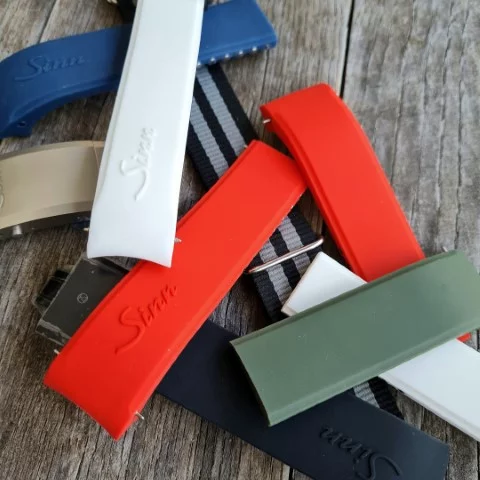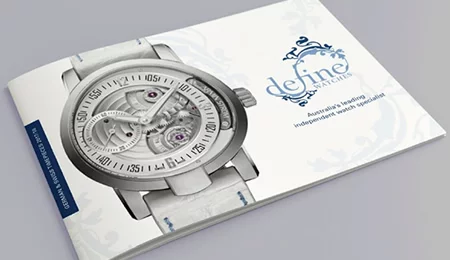Sometimes it’s the smallest details that have the biggest impact, and knowing what you’re talking about makes getting what you want much easier.
So, we thought we’d run a quick review of watch hand styles, how they look, and what to call them.
Of course, there are multiple variations on themes (talk about research rabbit holes!) but this is a general overview of the most common, classic styles we’ve come across, to get you started.
Where possible we’ve listed the English and French term as they are often interchanged in the watch world.
The Basics
Let’s wind back the clock (literally) – think back to learning to tell the time at primary school and Arrow (harpon) or Spade (poire) style hands may jump to mind. These styles are designed to indicate time quickly and clearly and are sometimes used for UTC indication as with Sinn’s 105 collection.
Arrow watch hands
Arrow watch hands (Harpon) are characterised by the arrow-like head at the tip of the hand. The intention is to enhance clarity with the arrowhead pointing to the minute, hour or time interval it is intended to show. Some of the most well-known watches to feature arrow style hands include Omega’s Seamaster and speedmaster collections, renowned for their legibility and enduring design.
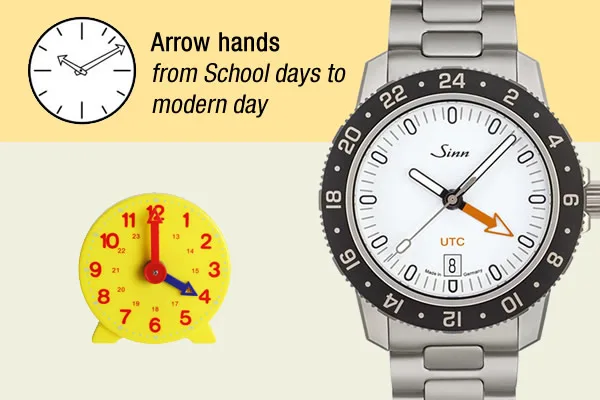
Spade watch hands
Spade watch hands (Poire) are characterised by a broad, shovel like tip on an otherwise straight or elongated stem. The tip resembles the spade shape on playing cards and is slightly more classic and refined than a straight arrowhead style. Spade hands can range in style from obvious, playful designs like those used by Alexander Shorokhoff through to elongated, fine spade tips such as those on Glashuette’s Original’s Senator chronometer.
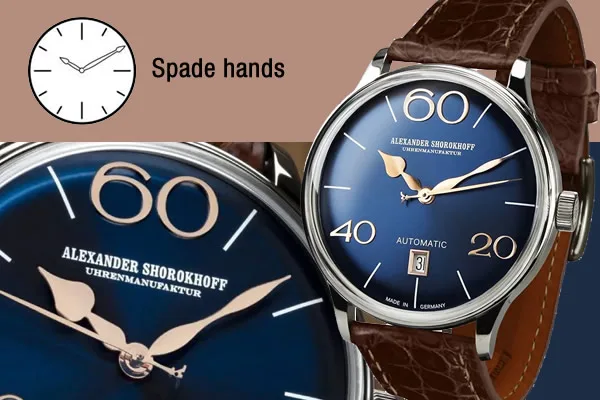
Baton (Baton) watch hands
Baton (Baton) watch hands are characterised by their minimalistic, straight design and lack of defining tip. These hands are often found on more modern designs with minimal complications and dial treatments such as Audemar Piguet’s Royal Oak, and Rolex’s Datejust and Rolex Oyster Perpetual. The emphasis is on streamlining the overall watch appearance and simplifying the design aesthetic without compromising on functionality. These types of hands are also used on sub complications such as second hands and small second dials to differentiate them from the hour and minute hands.
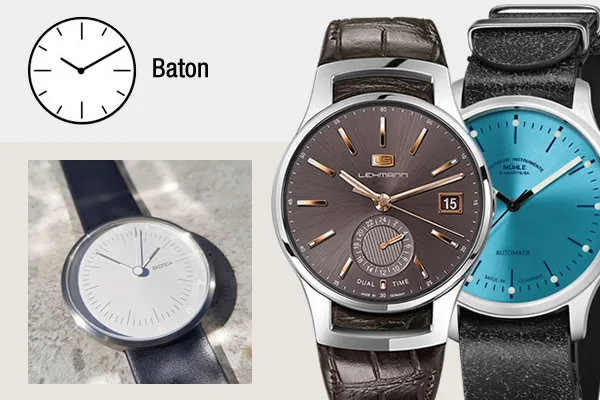
Syringe (Squelette) watch hands
Syringe (Squelette) watch hands take their name from the optical similarity to a syringe with a fuller body and thin, pointed end like a medical syringe. These types of hands often adorn instrument and sport watches as they allow for luminous material to be filled along the thicker part of the watch hand, which enhances legibility in dimly lit environments, thus increasing functionality. Sinn’s U1 collection is a shining example of syringe hands at their best and most functional.
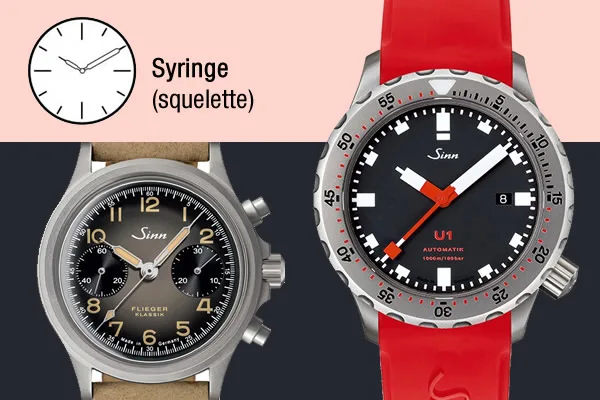
Sword (Glaive) watch hands
Sword (Glaive) watch hands are designed to deliver both easy legibility and a clean design aesthetic with a shape that resembles a sword blade. Classic timepieces such as Jaeger-LeCoultre’s Grand Reverso and Cartier’s Drive have adopted these styles of hands for exactly this reason.
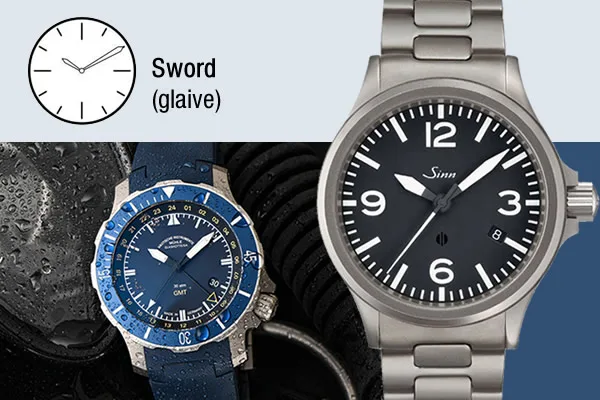
Mercedes (cathedral) hands
Mercedes (cathedral) hands derive their name from the three-point star, resembling the Mercedes logo, at the end of the hour hand. Despite the detail on the hour hand, the minute hand is simpler by design (often syringe, baton or sword in shape). The thickness and partitioning of the hands provide good surface area for luminous material to be applied to enhance legibility and promote functionality in various light environments. Rolex GMT watches feature this hand design as do other instrument-style watches such as Tutima’s Classic Pilot and Hanhart’s much-loved Mark I and MK II pilot watches.
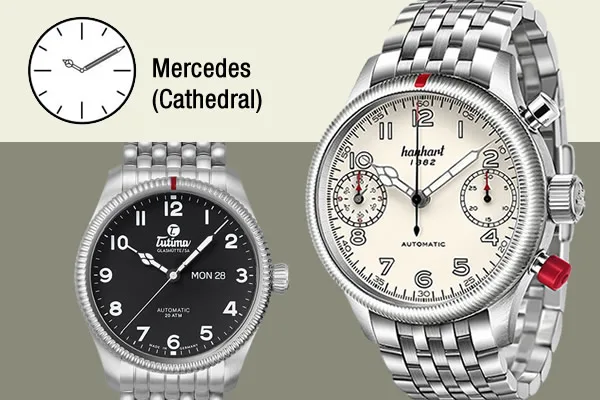
Alpha hands
Alpha hands are characterised by a tapered tip that starts from a wide base connected to the centre of the dial by a narrow stem giving them the appearance of a ‘stretched out A’. Such hands are elegant often feature in high end dress watches such as Lange & Sohne’s Lange 1 or Tutima’s Saxon One Chronoghraph.
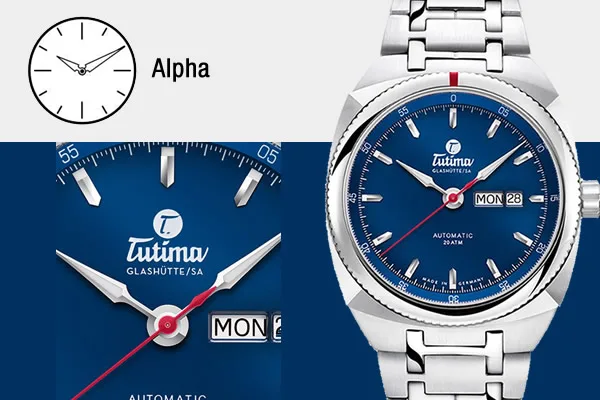
Dauphine hands
Dauphine hands are a traditional style often found on elegant dress watches. They are usually triangular in shape and taper towards each tip. Styles are often faceted or polished to enhance the crisp finish. The word dauphin comes from the French word for the eldest son of the king, though there is no clear link between the name and a royal connection. Classic examples of this style of hand in a faceted finish can be seen on Vacheron Constantin’s Traditionnelle timepiece and Patek Philippe’s stunning Calatrava, or as an unfaceted derivation on Tutima’s Aero Club.
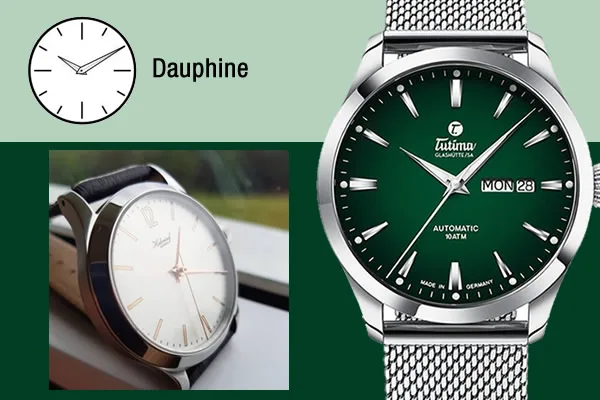
Leaf (Feuille) hands
Leaf (Feuille) hands are a French style often seen in classic dress watches such as IWC’s Portugieser and on small second sub dials. The curved shape features a wide middle that tapers at each end similar to a classic leaf shape. Designs can be thick or thin, short or elongated, polished or filled, depending on the desired effect. A popular finish for this style of hand is flame annealed (often blue) as the gentle curved surfaces lend themselves well to the flame-blue finish in order to catch and reflect light as seen on Habring2’s Chrono Felix with salmon dial. The simple design and elegant shape of these hands adds to their popularity in modern times.
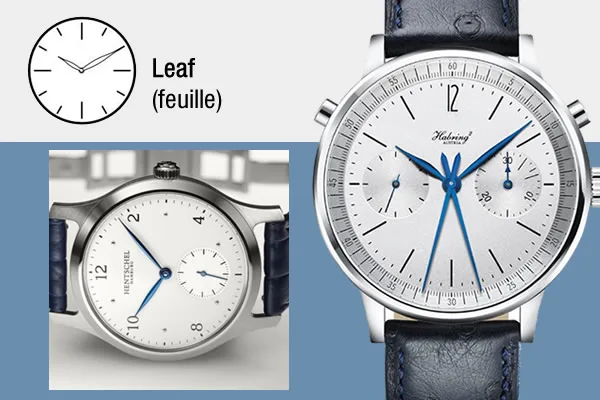
Louis XV hands
Louis XV hands are considered highly embellished hands that adorn several of Lang & Heyne’s more complicated pieces. These hands are meticulously handmade and hand annealed to give them their exquisite finish which reflects the extravagant Rococo style of the French Court.
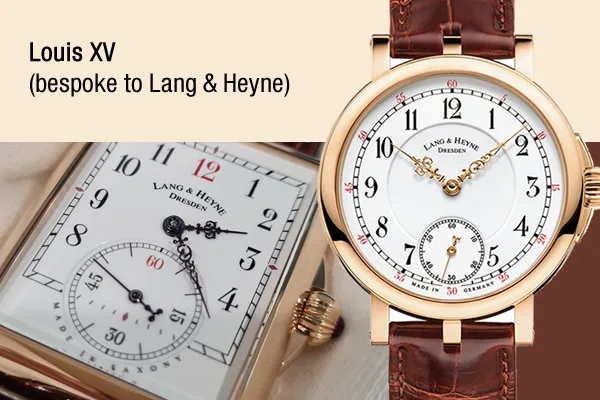
Classic Cathedral hands
Classic Cathedral hands are slightly less embellished than Louis XV style hands but reflect a restrained level of embellishment reminiscent of a time when design detail was king. While the emphasis is on legibility, a subtle undertone of design and finesse remains.
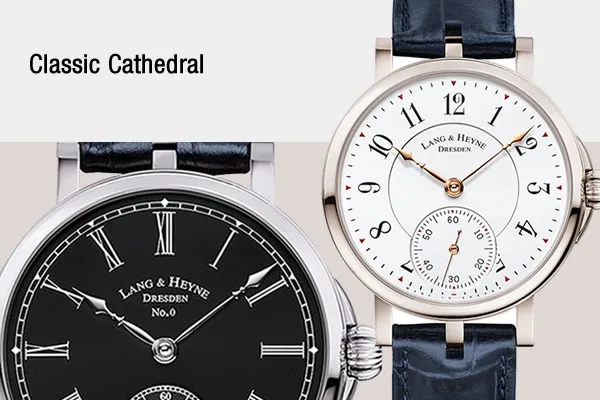
Breguet (pomme) style hands
Breguet (pomme) style hands take their name from their Swiss inventor and master watchmaker to the court of France, Abraham-Louis Breguet (1747-1823). They feature a circular hoop near the tip of an otherwise thin, long hand that ends in a sharp point. Because the hoop resembles a round apple, this style of hands is sometimes referred to as pomme (French for apple) hands. Classic examples are seen on vintage Breguet timepieces and can also be found on contemporary Breguet watches as well as many one-off Benzinger pieces that also display Breguet style guilloching on the dials.
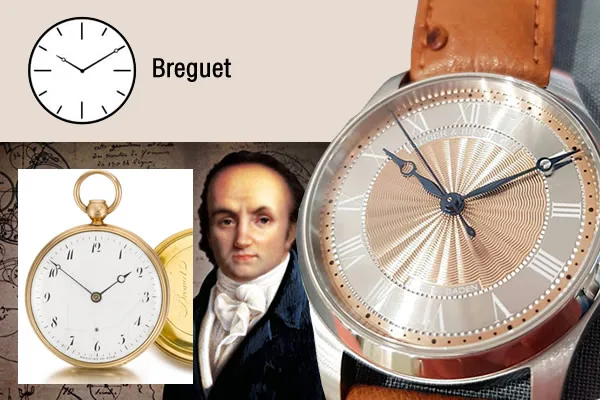
Lance hands
Lance hands are similar to Alpha hands but are generally slimmer and slightly more elongated and elegant by design as can be seem in Moritz Grossmann’s Atum Rose Gold and A. Lange & Sohne’s Lange 1.
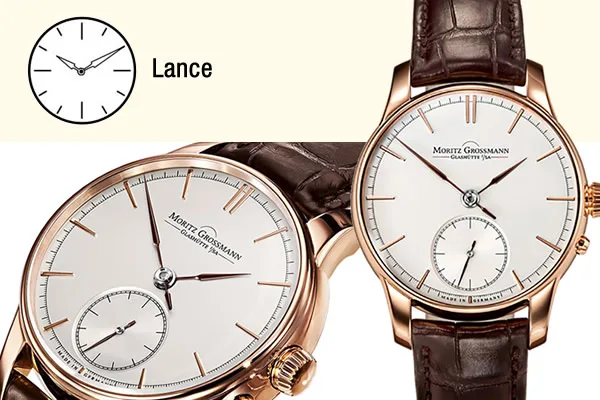
Unique and Specialty hands
Specialty hands are often driven by a design aesthetic and can be as creative as the designer wishes. Some shapes naturally lend themselves to watch hand formats like the Serpentine hand (snake-like wave) used by Alexander Shorokhoff, the bespoke tip design of the ‘A’ in Armin Strom’s Orbit, or the infinity hand on Kudoke’s K1. Whatever the design brief, in horology there is always a balance to be struck between functionality and form.
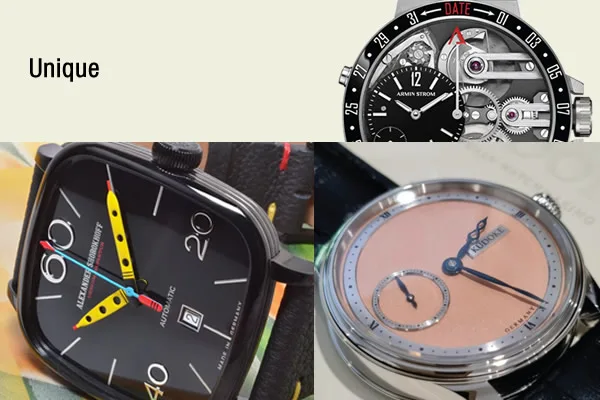
Conclusion
The world of watch hands is as diverse as it is fascinating, with each style offering a unique blend of functionality, design, and history. From the precise clarity of Arrow and Spade hands to the elegant simplicity of Baton and Syringe styles, and from the traditional elegance of Dauphine and Louis XV hands to the modern sophistication of Alpha and Breguet styles, each type of watch hand serves not only a practical purpose but also adds character and distinction to the timepiece. Understanding these various styles enriches the appreciation of watchmaking artistry and helps connoisseurs make informed choices in their quest for the perfect watch. As we’ve explored, the choice of hands is more than just a time-telling feature; it’s a statement of style, heritage, and personal preference, making the world of horology an endlessly intriguing journey.

